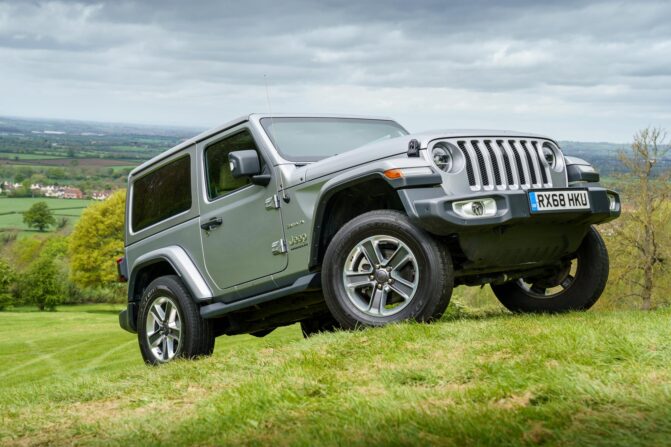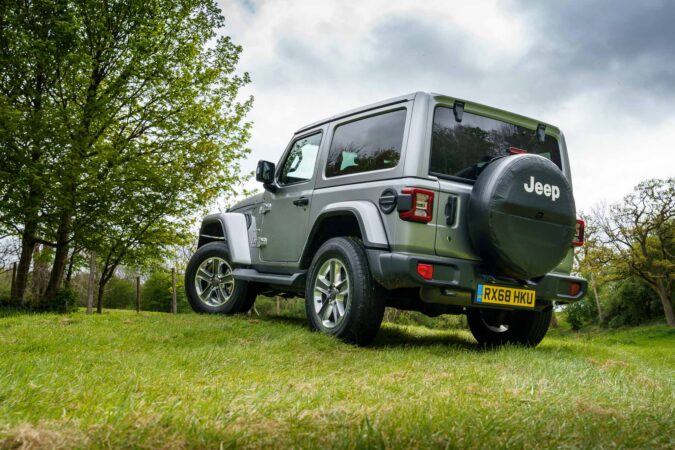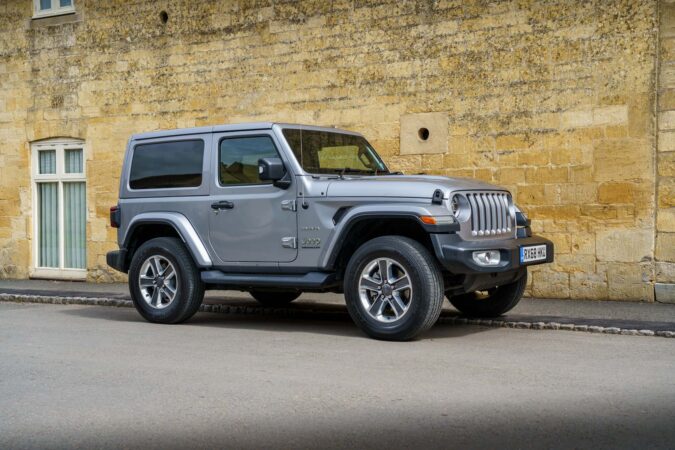Not all model years of the Jeep Wrangler are created equal, and the reliability of one model year might be far worse than others. In fact, some Jeep Wrangler model years have serious reliability issues that could cost you thousands in repairs! Some of the worst model years that we’ve found are the 2007 and 2012 Jeep Wranglers.
The latter two model years are plagued with problems such as engine failure, steering faults, and airbag defects. Other problematic and unreliable model years of the Jeep Wrangler also include the 2008, 2010, 2013, and 2015 models. On the other hand, the 2018 model year Jeep Wrangler, for the time being, seemed quite reliable!
Of course, if you’re buying a Jeep Wrangler, it’s crucial to know which model years to avoid at all costs, and which model years are relatively safe. Below, we’ll break down some of the worst model years of the Jeep Wrangler by reliability, and what problems typically plague them:
| Model Year | Main Issues | Recalls |
|---|---|---|
| 2007 | Engine failure, steering issues (death wobble), airbag defects, as well as fuel system problems | 10 |
| 2008 | TIPM failure (stalling, poor performance), excessive oil consumption, fuel and drivetrain issues | 9 |
| 2010 | Oil consumption leading to engine failure, electrical issues, and faulty accessories (window regulators, door handles) | 5 |
| 2012 | Engine failure, TIPM failure, airbag defects, heater malfunctions, in addition to drivetrain issues | 20+ |
| 2013 | TIPM failure (stalling while driving), airbag deployment issues, and cooling system faults (overheating) | 10+ |
| 2015 | Transmission failure (gear slippage), fuel pump issues, in addition to recurring death wobble | 6 |
2007 Jeep Wrangler
The 2007 Jeep Wrangler had 10 recalls to its name, affecting owners with countless issues. These include fuel system problems to steering issues – the latter is the #1 fault with the 2007 Wrangler, according to the NHTSA. Additionally, there were reports of faults with the airbags, as well as the ‘death wobble’, aka harsh vibrations and shaking.
According to some owners who’ve had this issue repaired, the death wobble, on average, costs $800 to repair. On top of that, engine failure is another significant problem. Owners complained about total engine failure, and the cost of repairing or replacing the engine was around $4,400. Additionally, the 2007 Wrangler had problems with its brakes, too.
Reliability Scores, Common Problems, & What Owners Say
- J.D. Power: ⭐⭐ (2/5)
- Consumer Reports Predicted Reliability: Poor
- CarComplaints.com Reports: 1,903 complaints (Most reported issue: “Death Wobble”)
As we discussed earlier, some of the most common problems with the 2007 model year Jeep Wrangler include:
- Engine stalling and total engine failure
- Steering instability (“Death Wobble”)
- Airbag system malfunctions
And, to give you some more context, here’s what owners have to say about the 2007 Wrangler:
- “I’ve had constant issues with the front-end wobbling after hitting a small bump. Jeep says it’s normal, but it’s terrifying at highway speeds!” – Reddit user @WranglerTrek
- “Had to replace the engine at 95,000 miles after an oil pressure drop. This is absurd for a car that’s supposed to be ‘rugged.’” – CarComplaints.com User “JeepOwner2007”
- “The 2007 Wrangler introduced the JK generation, but it had major teething issues. Jeep rushed production, leading to steering defects and weak engine durability.” – Jake Spencer, Certified Jeep Mechanic
2012 Jeep Wrangler
While the 2007 Jeep Wrangler might’ve been bad, the 2012 model year was worse in terms of reliability. Many critics and owners rate it as the worst and most unreliable model year, with 10 more recalls added to its name. Common faults include airbag failure, the death wobble (better than 2007, at least), TIPM systems failure, and more engine problems.
The latter of which often required owners to rebuild or replace the engine entirely, to a tune of $4,400 or more. Aside from that, other faults with the 2012 Jeep Wrangler included woes with the heater and miscellaneous drivetrain faults. You might experience problems like stalling and hard starting. Therefore, it’s wise to avoid the 2012 Wrangler at all costs.
Reliability Scores, Common Problems, & What Owners Say
- J.D. Power: ⭐⭐½ (2.5/5)
- Consumer Reports Predicted Reliability: Below Average
- CarComplaints.com Reports: 1,548 complaints (Most reported issue: “TIPM Failure”)
As we mentioned earlier, some of the most common issues with the 2012 model year Jeep Wrangler include:
- TIPM (Totally Integrated Power Module) failures
- Cylinder head issues leading to misfires
- Airbag sensor malfunctions
To give you a bit more insight into how bad this model year is, here’s what owners have to say about the 2012 Wrangler:
- “Jeep replaced my TIPM module twice before 80,000 miles. Without warning, my Wrangler wouldn’t start, the horn blared randomly, and the wipers activated on their own.” – JeepForum user “WranglerMike12”
- “The cylinder head issue ruined my Wrangler experience. I was quoted $4,500 for repairs – unacceptable for a car I took great care of.” – CarComplaints.com User “UnhappyWrangler”
- “The 2012 Wrangler suffered from persistent TIPM failures, leading to electrical nightmares. Owners frequently reported no-start issues, flashing dash lights, and airbag warning lights.” – Tom Weller, Automotive Electrical Specialist
2008 Jeep Wrangler
Since we’ve already covered the 2007 and 2012 Jeep Wranglers – the worst in terms of reliability by model year – it’s a good idea to cover some of the other unreliable model years, too. Just like the 2007 model, the 2008 Jeep Wrangler didn’t fix much. The most systemic issue was a complete failure of the Wrangler’s TIPM (Totally Integrated Power Module).
A failure of the TIPM would result in further issues, such as stalling and poor performance. However, repairing the TIPM isn’t cheap, likely costing you around $800 to $1,000. Moreover, the 2008 Wrangler was plagued with other problems, such as excessive oil consumption, fuel system issues, steering problems, and drivetrain faults. None are cheap to fix.
Reliability Scores, Common Problems, & What Owners Say
- J.D. Power: ⭐⭐ (2/5)
- Consumer Reports Predicted Reliability: Poor
- CarComplaints.com Reports: 1,218 complaints (Most reported issue: “Engine Stalling”)
As we’ve been discussing thus far, among the most typical problems with the 2008 model year Jeep Wrangler include:
- Premature engine failure
- Electrical system malfunctions
- Airbag deployment failure
To show you just how bad this model year is, here’s what owners have been saying about the 2008 Wrangler:
- “My 2008 Wrangler kept stalling randomly. Sometimes it wouldn’t restart, leaving me stranded. Mechanics couldn’t figure out why!” – CarComplaints.com User “FrustratedJeep08”
- “Electrical gremlins everywhere! My dash lights flicker, my radio shuts off, and my power windows work only when they feel like it.” – WranglerForum User “JeepDude08”
- “The 2008 Wrangler had lingering issues from the 2007 model, particularly with engine reliability and electrical faults. Chrysler’s cost-cutting measures showed in this model year.” – Mike Reynolds, Certified Jeep Technician
2010 Jeep Wrangler
The 2010 Jeep Wrangler model year did notice some improvements compared to its predecessors. Alas, it still had issues of its own, such as engine problems. In particular, the oil-burning issue from earlier reared its ugly head, causing your car to consume excessive amounts of motor oil. It could even lead to severe engine failures and require costly repairs.
There were also concerns related to the 2010 Wrangler’s electrical system, causing further issues with its ignition and intermittent starting. If that isn’t bad enough, the accessories on the 2010 Wrangler are problematic, too. This encompassed faulty window regulators, broken door handles, and defects with the interior trim that upset many owners.
Reliability Scores, Common Problems, & What Owners Say
- J.D. Power: ⭐⭐½ (2.5/5)
- Consumer Reports Predicted Reliability: Below Average
- CarComplaints.com Reports: 862 complaints (Most reported issue: “TIPM Electrical Failures”)
Echoing what we’ve been saying about the 2010 model year Jeep Wrangler so far, here are some common issues to look out for:
- TIPM (Totally Integrated Power Module) failure
- Steering vibration at highway speeds
- Oil leaks and excessive consumption
As a showcase of what you need to look out for, here are some handy anecdotes from owners of 2010 Wranglers:
- “TIPM issues are a nightmare. My Wrangler wouldn’t start one day, and then the next day, my horn would go off randomly in the middle of the night!” – Reddit user @JeepNightmare10
- “I was told by my mechanic that my engine was leaking oil internally, and Jeep refused to cover it under warranty. Never buying another Jeep again.” – CarComplaints.com User “OilBurner2010”
- “The TIPM module in the 2010 Wrangler was a well-known defect, causing everything from no-start issues to unpredictable electrical behavior. It’s an expensive repair, often requiring a complete module replacement.” – John Mathews, Automotive Electrical Expert
2013 Jeep Wrangler
There were hopes that following the problem-prone 2012 model year, the 2013 Wrangler would fix most of the aforementioned issues. It did see a decrease in the frequency of overall issues, but it wasn’t immune to faults. The most prominent point of failure was the TIPM system once more, which could lead to unexpected stalling while you’re driving.
In addition, there were airbag-related issues, where they may not deploy during collisions. The cooling system was flawed too, and many owners noted that their 2013 Wranglers constantly overheated. This is particularly bad for folks who regularly use their Jeep Wranglers off-road or for extended road trips. Repairing this could cost you upward of $1,000.
Reliability Scores, Common Problems, & What Owners Say
- J.D. Power: ⭐⭐½ (2.5/5)
- Consumer Reports Predicted Reliability: Below Average
- CarComplaints.com Reports: 957 complaints (Most reported issue: “Cylinder Head Failure”)
To summarize the common problems with the 2013 Jeep Wrangler thus far, here’s what you need to look out for:
- Cylinder head cracking leading to misfires
- Fuel system problems that cause engine hesitation
- Oil consumption and leaks
And, to give you some real-world context into these issues, here’s what 2013 model year Jeep Wrangler owners have to say about its reliability:
- “Jeep refused to acknowledge the cylinder head issue until I was out of warranty. Now I’m stuck with a $5,000 repair bill.” – CarComplaints.com User “BurnedByJeep13”
- “Gas pedal response is inconsistent. Sometimes my Wrangler hesitates before accelerating, and the dealership says there’s no fix.” – WranglerForum User “LaggyJeep2013”
- “2013 Wranglers had a poorly designed cylinder head that led to misfires and eventual failure. It was a well-documented issue, but Jeep refused to recall it.” – Steve Johnson, Master Jeep Mechanic
2015 Jeep Wrangler
There were huge expectations that the 2015 Wrangler might help improve its reliability overall. But, it did come with its own set of problems. Most notably, the transmission was prone to gear slippage, and in some cases, complete transmission failure. Given how complex a Wrangler’s transmission is, fixing these issues could cost owners $2,000 or more.
Owners of the 2015 Jeep Wrangler also expressed disappointment with the fuel system. Owing to a fuel pump issue, the Wranglers of this era sometimes found themselves struggling to start. Plus, the 2015 model year wasn’t exempt from the infamous death wobble, as mentioned earlier, leaving drivers uneasy about their vehicle’s ride quality.
Reliability Scores, Common Problems, & What Owners Say
- J.D. Power: ⭐⭐⭐ (3/5)
- Consumer Reports Predicted Reliability: Below Average
- CarComplaints.com Reports: 877 complaints (Most reported issue: “Powertrain Issues”)
Here are some of the most common problems with the 2015 model year Jeep Wrangler so far, that you should be wary of:
- Driveshaft failure
- Erratic fuel gauge readings
- Premature clutch wear (manual models)
Moreover, for added insight, here’s what owners of the 2015 model year Jeep Wrangler have to say about its reliability:
- “Fuel gauge is completely unreliable. I ran out of gas twice because it showed I had a quarter tank left!” – Reddit user @JeepGasGone
- “Had my driveshaft replaced at 60,000 miles. The dealership said it was ‘normal wear’—I call it poor quality.” – CarComplaints.com User “NoDriveshaft14”
- “The 2014 Wrangler had a surprising number of powertrain failures. Many owners reported transmission and driveshaft issues, even at low mileage.” – Derek Hughes, Jeep Performance Technician
Cost Of Ownership, Repairs, And Maintenance
Now that we’ve gone through some of the worst model years by reliability for the Jeep Wrangler, this now begs the question… Are they expensive to maintain? Owning a Jeep Wrangler comes with comparatively high running costs, especially for older or unreliable model years.
So, to give you some context of what you should expect if you’re planning on buying a used Jeep Wrangler, we’ll break down some of the common repair costs, maintenance costs, as well as long-term reliability concerns for various Wrangler model years.
1. Repair Costs By Model Year
As we discussed earlier, some Jeep Wrangler model years have recurring problems that lead to costly repairs. Here’s how much each of the model years we mentioned thus far might cost you with their respective repair costs:
| Model Year | Common Repairs | Average Repair Cost |
|---|---|---|
| 2007 | Engine replacement, steering repairs (death wobble), and airbag module replacement | $4,000 – $6,000 |
| 2008 | TIPM failure, oil consumption issues, as well as drivetrain problems | $1,500 – $3,500 |
| 2010 | Oil-burning repairs, electrical system issues, in addition to accessory replacements | $1,200 – $2,800 |
| 2012 | Engine rebuild, TIPM failure, not to mention airbag system repairs | $3,500 – $6,500 |
| 2013 | TIPM module replacement, cooling system repairs, and airbag deployment failures | $2,000 – $4,500 |
| 2015 | Transmission replacement, fuel pump issues, as well as suspension/steering fixes | $2,500 – $5,000 |
2. Routine Maintenance Costs
Irrespective of which Jeep Wrangler model year you own, as with any car, Jeep Wranglers require regular maintenance. Practicing routine servicing ensures long-term performance, and it might even help with preventing or reducing the chances of some problems appearing. Here’s how much routine maintenance costs for the Jeep Wrangler:
| Service | Estimated Cost | Frequency |
|---|---|---|
| Oil Change | $80 – $120 | Every 5,000 – 7,500 miles |
| Brake Pad Replacement | $250 – $400 | Every 40,000 – 60,000 miles |
| Transmission Fluid Change | $150 – $250 | Every 30,000 – 60,000 miles |
| Tire Replacement (All-Terrain Tires) | $800 – $1,500 (set of 4) | Every 40,000 – 50,000 miles |
| Suspension & Steering Alignment | $100 – $200 | Annually or as needed |
3. Long-Term Reliability & Cost Factors
Besides repair costs and routine maintenance, there are other expenses that you should consider if you’re thinking of buying a Jeep Wrangler:
- High-Mileage Repairs – Some older Jeep Wrangler models (pre-2015 usually) may require expensive engine or transmission repairs or rebuilds beyond 100,000 miles.
- Off-Road Wear & Tear – Wranglers driven off-road frequently will need more frequent suspension, brake, and drivetrain repairs and maintenance.
- Warranty Coverage – Buying a certified pre-owned (CPO) Jeep Wrangler or getting an extended warranty could help with offsetting major repair costs.
What Model Year Of The Jeep Wrangler Is The Most Reliable?
As we noted earlier, the 2018 Jeep Wrangler is often considered to be the best and most reliable model year that you can find on the used market today. Not only is it reliable, but as a package, critics reviewed it positively, too. It had good fuel economy (for a Wrangler), and performance from the 3.6-liter V6 engine was widely praised.
This also made it ideal for off-roading over steep terrains, mud pits, and rocky trails. With 25 mpg in the city and 27mph on the highway, it’d be a great daily driver, too. Granted, the 2018 model wasn’t immune to problems, as it still has its fair share of issues. These include loose steering, structural problems, bad welding, and faults with its electronics.



